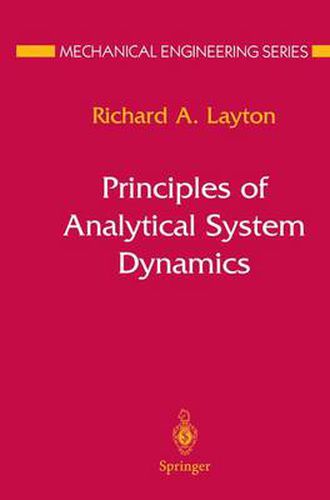Readings Newsletter
Become a Readings Member to make your shopping experience even easier.
Sign in or sign up for free!
You’re not far away from qualifying for FREE standard shipping within Australia
You’ve qualified for FREE standard shipping within Australia
The cart is loading…






This title is printed to order. This book may have been self-published. If so, we cannot guarantee the quality of the content. In the main most books will have gone through the editing process however some may not. We therefore suggest that you be aware of this before ordering this book. If in doubt check either the author or publisher’s details as we are unable to accept any returns unless they are faulty. Please contact us if you have any questions.
This book describes a novel approach to analytical mechanics that uses differential-algebraic equations, which, unlike the usual approach via ordinary differential equations, provides a direct connection to numerical methods and avoids the cumbersome graphical methods that are often needed in analyzing systems; it is also eminently suited for constrained nonlinear models. Using energy as a unifying concept and systems theory as a unifying theme, the book addresses the foundations of such disciplines as mechatronics, concurrent engineering, and systems integration. The systems considered include mechanical, thermal, electrical, and fluid elements; only discrete systems are considered. The reader is expected to be familiar with the fundamentals of engineering mechanics, but no detailed knowledge of analytical mechanics, system dynamics, or variational calculus is required. The treatment is thus accessible to advanced undergraduates, and the interdisciplinary approach should be of interest not only to academic engineers and physicists, but also to practicing engineers and applied mathematicians. The text begins with an overview of system dynamics: classification and representation of motion, constraints on motion, virtual work and variational concepts. It then turns to the Lagrangian and Hamiltonian equations of motion, expressed as differential-algebraic equations. A subsequent chapter treats the dual, or complementary equations of motion, and the book concludes with a chapter on modeling and simulation, including methods of numerical solution.
$9.00 standard shipping within Australia
FREE standard shipping within Australia for orders over $100.00
Express & International shipping calculated at checkout
This title is printed to order. This book may have been self-published. If so, we cannot guarantee the quality of the content. In the main most books will have gone through the editing process however some may not. We therefore suggest that you be aware of this before ordering this book. If in doubt check either the author or publisher’s details as we are unable to accept any returns unless they are faulty. Please contact us if you have any questions.
This book describes a novel approach to analytical mechanics that uses differential-algebraic equations, which, unlike the usual approach via ordinary differential equations, provides a direct connection to numerical methods and avoids the cumbersome graphical methods that are often needed in analyzing systems; it is also eminently suited for constrained nonlinear models. Using energy as a unifying concept and systems theory as a unifying theme, the book addresses the foundations of such disciplines as mechatronics, concurrent engineering, and systems integration. The systems considered include mechanical, thermal, electrical, and fluid elements; only discrete systems are considered. The reader is expected to be familiar with the fundamentals of engineering mechanics, but no detailed knowledge of analytical mechanics, system dynamics, or variational calculus is required. The treatment is thus accessible to advanced undergraduates, and the interdisciplinary approach should be of interest not only to academic engineers and physicists, but also to practicing engineers and applied mathematicians. The text begins with an overview of system dynamics: classification and representation of motion, constraints on motion, virtual work and variational concepts. It then turns to the Lagrangian and Hamiltonian equations of motion, expressed as differential-algebraic equations. A subsequent chapter treats the dual, or complementary equations of motion, and the book concludes with a chapter on modeling and simulation, including methods of numerical solution.